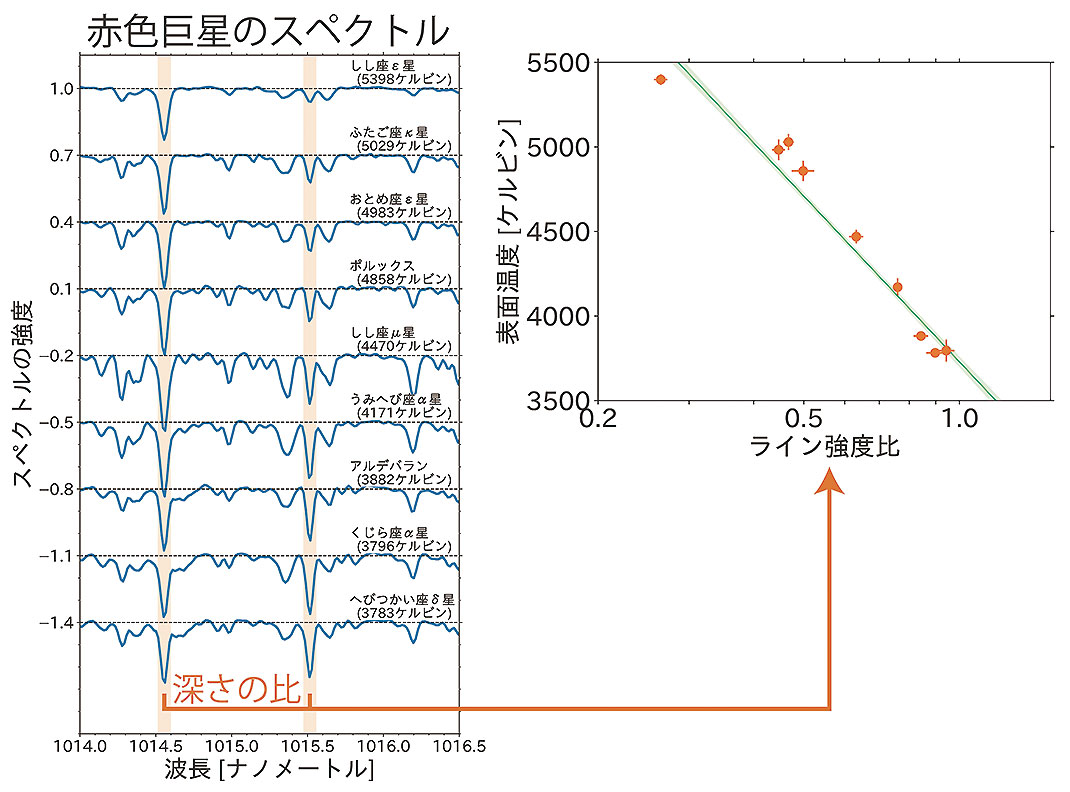Disclaimer: machine translated by DeepL which may contain errors.
Toward Accurate Measurement of Stellar Temperatures
Daisuke Taniguchi(2nd Year Doctoral Student, Department of Astronomy) |
Noriyuki Matsunaga( Assistant Professor, Department of Astronomy) |

The starry sky shows various expressions in each season. Among them, Orion, which occupies a corner of the winter sky, has two first magnitude stars with contrasting colors, giving it a strong presence. Rigel, shining on the left foot, is a bluish-white supergiant, while Betelgeuse, shining on the right shoulder, is a red star of the type called a red supergiant. We learn in high school science class that these colors are related to the surface temperature of the star, but how is that temperature measured?
The most basic method of measuring temperature is probably based on the measurement of visual diameter using an interferometer. Since the apparent brightness of a star depends on its visual diameter and surface temperature, the remaining temperature can be calculated if the apparent brightness and visual diameter are obtained from observations. This method works for blue stars like Rigel and red giants (stars similar in color to red supergiants but slightly smaller and fainter), but not so well for red supergiants like Betelgeuse. The visual diameter of Betelgeuse has been measured over the past 100 years, but it is now known that the magnitude varies with the wavelength of observation. This means that it is not possible to calculate the temperature based on the visual diameter measured at any wavelength.
Some attempts have been made to compare the intensity of molecular absorption lines (mainly TiO molecules; absorption becomes stronger at low temperatures) in the spectra of red supergiants with theoretical calculations via a stellar atmosphere model. However, the accuracy of this method is also questionable. It is still difficult to accurately model the dark/dark speckles on the surface of a red supergiant star or the large region of molecular photosphere that extends to the outer edge of the stellar atmosphere.
In view of the above problems, a temperature measurement method that does not depend on stellar atmosphere models and does not use molecular absorption lines is desirable. We used an empirical method based on the depth of iron absorption lines in the near-infrared spectrum from 0.97 to 1.32 μm, and found a good correlation between the depth ratio (line intensity ratio) of the two absorption lines and the stellar temperature if the two absorption lines are well selected. By calibrating this relationship with observations of red-giant stars with known temperatures, we thought we should be able to apply it to red supergiants and accurately measure their temperatures.
 |
| Figure: Example of the relationship between line intensity ratio and temperature. The figure shows an example of the relationship between line intensity ratio and temperature for a red-giant star whose temperature is already well known from interferometric observations. By applying the relationship obtained here, we measured the temperature of red supergiant stars such as Betelgeuse. Left: Examples of spectra of red-giant stars (in order of increasing temperature). The iron-atom absorption lines on the left do not change in depth for stars with different temperatures, but the iron-atom absorption lines on the right are deeper for colder stars. Right: The ratio of the depths of these two iron-atom absorption lines (line strength ratio) to temperature. |
In fact, we found many beautiful relationships as shown in the figure and succeeded in measuring the surface temperatures of 10 red supergiant stars in the solar neighborhood (Betelgeuse is 3611 K). We believe that further observations of red supergiants in nearby galaxies, such as the Large and Small Magellanic Clouds, will make it possible to accurately and easily measure the temperatures of red supergiants in various environments. By comparing these temperatures with the stellar evolution theory in detail, we expect to approach the important question of how stars evolve to become red supergiants and how they die in supernova explosions, which is an important issue in the fields of both stellar physics and galactic astronomy.
The results of this study were published in D. Taniguchi et al. , Monthly Notices of the Royal Astronomical Society 502, 4210 (2021).
Published in the July 2021 issue of Faculty of Science News
Communicating to Faculty Research Students >



